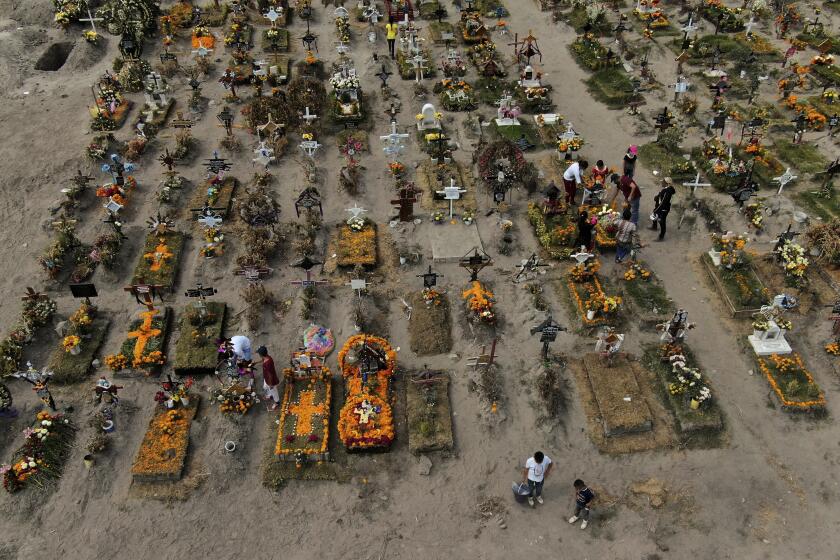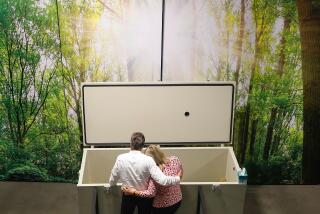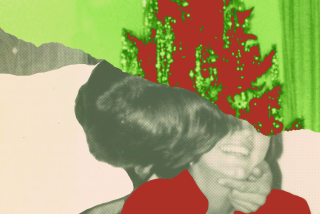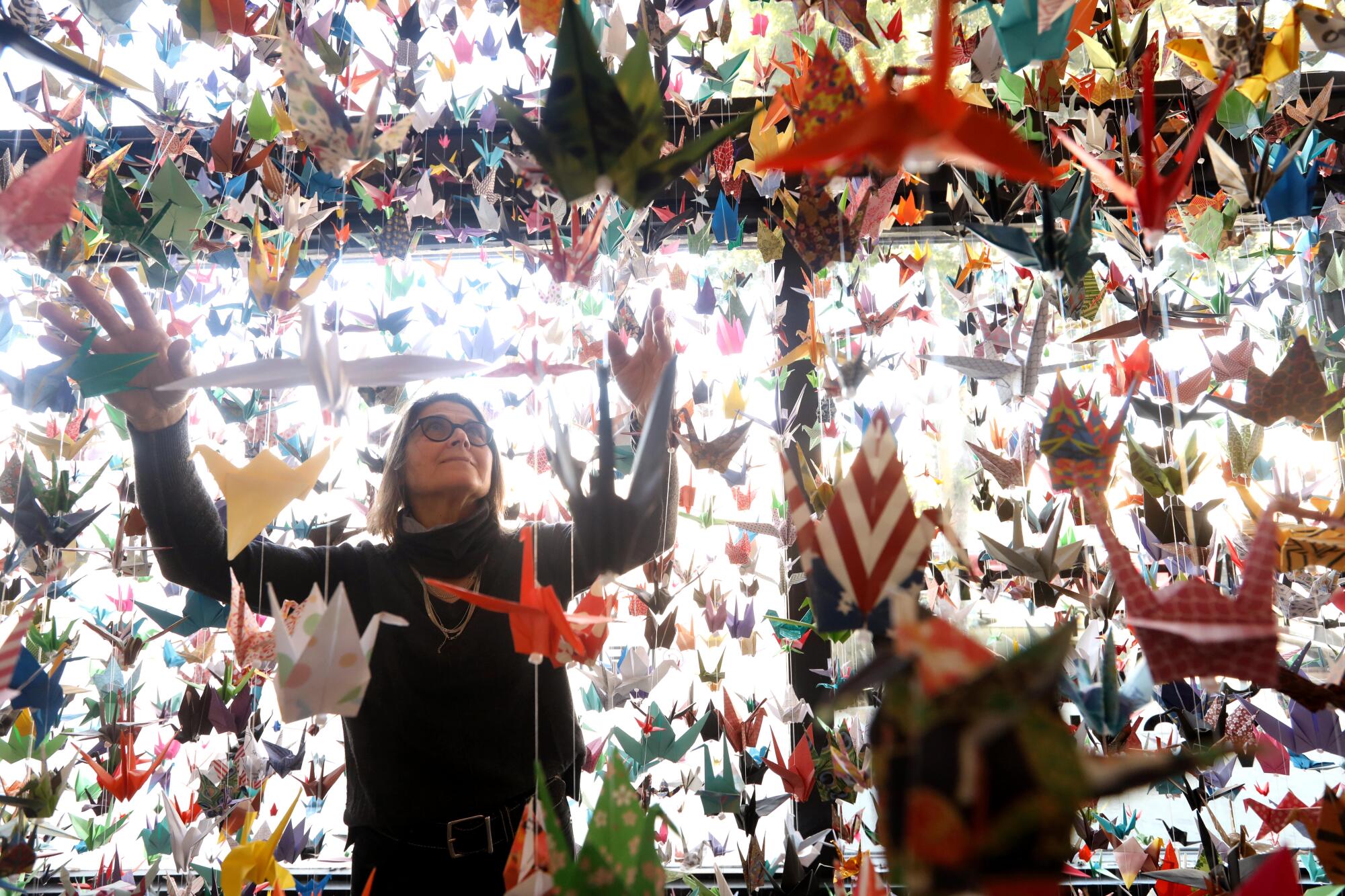
It was a nightly ritual for Karla Funderburk that began the second week of April. She watched in horror as news stories showed the scenes playing out in New York that eventually would spread across the country: Overflowing morgues. Refrigeration trucks pulling up behind hospitals. Despondent families unable to spend final moments with loved ones.
While she watched, she folded paper cranes and dropped them into a bag by her bed — one crane for each person who had died from COVID-19.
“I started just for myself,” the Los Angeles art gallery owner said. “It was a way for me to process.”
Cranes represent the soul being safely transported to its next incarnation, she said. And the origami process of folding them — 52 steps — became a form of meditation, a way to contemplate a life lost.
But in mid-May, when the U.S. death toll reached 90,000, Funderburk crunched some numbers. At the pace she was going, it would take her 29 years to finish.
So she issued a call for help on social media and in an email to supporters of her Matter Studio Gallery in Mid-City. As the tangible tributes came pouring in, she strung them from the ceiling.
Her first installation was just shy of 8,000 cranes. She has since received more than 60,000 from 45 states and nine countries from as far away as Tibet.
“We are collectively feeling the loss,” Funderburk said. “So I think just collectively mourning and acknowledging it provides a level of healing that is hard to translate into words.”
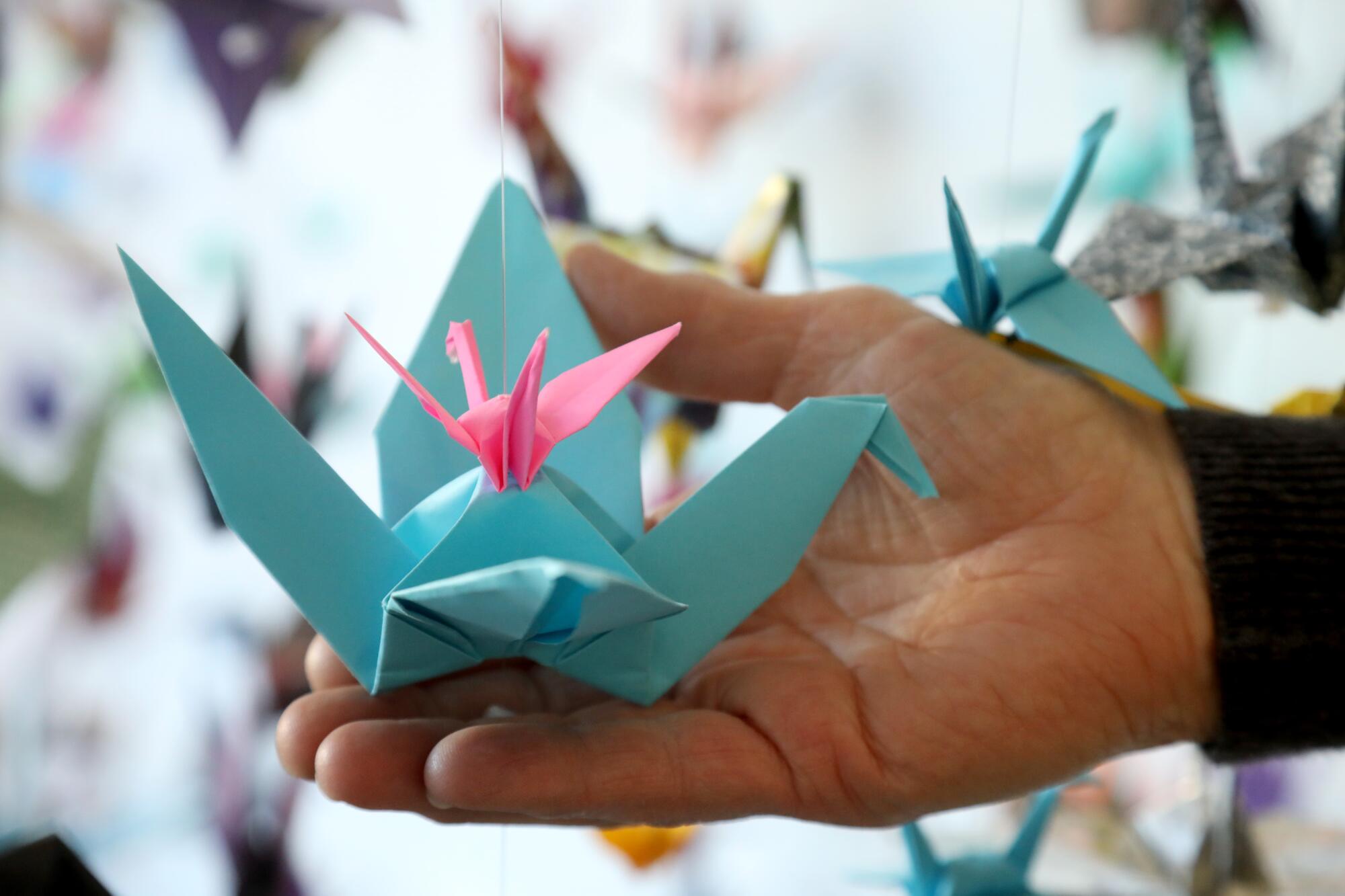
She is not alone in using objects to express what words cannot. Grassroots COVID-19 memorials have risen across the nation, particularly in the wake of a vicious winter surge that stole thousands of lives and upended millions more.
“Grief is an extraordinarily powerful, debilitating emotion,” said David Sloane, professor at the Price School of Public Policy at USC and an expert on death and dying. “And rituals were created to help us survive and to in some ways deal with that emotion.”
But the sheer numbers — 463,000 dead nationwide and counting — have eclipsed even the most resolved efforts to chronicle them.
The pandemic’s toll: Lives lost in California
Hundreds of people have died in California due to the COVID-19 pandemic. These are some of their stories.
Los Angeles artist Marcos Lutyens is attempting to mark every U.S. death with a red rose made of felt. He teaches people to make them during Zoom workshops with schools, Scout troops, senior homes and Kiwanis clubs.
“The actual installations are almost the tip of the iceberg,” he said. “Underneath it all is the process of grieving, this kind of conversation.”
“We recognize that when one life is lost, it isn’t just a single person that’s affected. There’s tens or hundreds, possibly even 1,000 people that are impacted by that one individual.”
— Cynthia Stewart
The roses people send him often come with stories of loss.
“I’m still trying to process that he’s gone and none of us could be there when he passed,” one woman wrote of her father, whom she called the most important person in her life.
“I’d spoken to him in the morning,” she added, “and he said he was feeling better and looking forward to coming home. Within hours he was gone.”
Lutyens mounts the flowers onto panels of netting to create shroud-like memorials. One adorns a mural in Boyle Heights, with the roses marking the lives lost there and in East Los Angeles. Another, in a Santa Monica art gallery, pays tribute to those who have died on the Westside.
Even with help from the community, Lutyens has found the task of keeping the installations up to date “almost Sisyphean.”
He last updated the Boyle Heights memorial in mid-December: 230 roses. By late January, deaths in the hard-hit area had reached 480. The Westside memorial had 381 roses when it went up Dec. 3. Less than two months later, it needed 465 more. That the largely affluent Westside is roughly seven times the size of Boyle Heights and East L.A. is a stark reminder of the inequities in how the health crisis is playing out, he noted.
“I think there’s a loss of scale after a certain number,” Lutyens said. “I mean, how many deaths are manageable to visualize?”
A daylong installation that Lutyens set up at Hollywood Forever Cemetery to coincide with a Jan. 19 national memorial event drove the statistics home. Early that morning, the nation’s COVID-19 death toll surpassed 400,000. Their bodies could fill the vast 80,000-grave cemetery five times.
“Sometimes I go to bed at night, and I have nightmares about everything that’s been going on,” Lutyens said. “So I am processing this on the inside.”
Lutyens estimates he has gathered about 5,000 roses, but by March 1, 2022, he hopes to be able to fully represent the death toll at a national memorial in Washington, D.C. He figures he’ll need somewhere between 495,000 and 595,000 more.
The pandemic has quieted one of the country’s signature holidays — Día de los Muertos, or Day of the Dead, when Mexicans honor deceased loved ones in often-boisterous fashion.
While Los Angeles has been the epicenter of California’s COVID-19 deaths, the recent wave of suffering left no corner of the state untouched.
In the sun-drenched Santa Ynez Valley, Anne Guynn still finds paper hearts strewn about her family’s walnut orchard.
She had started stringing garlands of them from a tree to mark California’s death toll in the spring, and by June, she had hung up more than 5,700. The grove became somewhat of a local landmark.
“Unfortunately, very quickly the numbers became too much to keep up with, and I was unable to continue the project,” Guynn wrote in an email.
She took down the hearts in December, but occasionally comes across a wind-swept relic among the trees that reminds of her of the state’s record deaths.
Farther north, rural Nevada County is home to fewer than 100,000 people and had recorded just 10 deaths in the beginning of December, when about a dozen residents started holding regular Zoom meetings and phone calls to come up with a way to memorialize their neighbors.
A local lumber company donated rebar. A woodworker donated wood and fashioned crosses and Stars of David. Two other community members painted the markers white, and a small group installed them on a hillside facing Highway 49, across from Sierra Nevada Memorial Hospital, on land donated by a storage company.
“This is a community of members helping members,” said Cynthia Stewart, who owns a marketing business in Grass Valley and organized the memorial. “It’s one of the reasons I moved up here 20 years ago.”
By the time the group dedicated the memorial on Jan. 19, it had installed 73 crosses and stars. Two days later, following the death of another resident, it added one more cross.
“For a community this small, losing 74 members in a short period of time is difficult,” Stewart said. “And we recognize that when one life is lost, it isn’t just a single person that’s affected. There’s tens or hundreds, possibly even 1,000 people that are impacted by that one individual.”
More Americans are simultaneously grieving than at perhaps any other time in modern history. All at once, the pandemic has stripped friends and family of the ability to hold a loved one’s hand on his or her deathbed or gather at a church for a funeral, said USC’s Sloane, whose book “Is the Cemetery Dead?” examines American traditions around death.
“If you can’t go see your friend who passed away, you can’t go hang out with your loved ones, then I think you are more likely to put a rose out or put a light in the window or put up a simple statement of your loss,” Sloane said.
Such acts can help people feel they’re taking back a little bit of power in a situation they cannot control, he said.
“It can help you integrate that death, and maybe more broadly death itself, into how you see life,” he said.
But how does someone integrate 100 deaths? 100,000?
Those who create the memorials describe a tension: On the one side, the desire to represent the almost inconceivable number of victims in a way that illustrates the immenseness of all that has been lost. On the other, the hope to remember the human stories behind the statistics.
“When you hear 400,000, you don’t think people, you just think numbers,” said Madeleine Fugate, 14, who is working on a quilt with each square representing a person who has died of COVID-19 in the U.S. “But when you really get to see who these people were, it sort of brings them back alive and you can heal from that, knowing they’re remembered.”
The Studio City teen started the quilt last school year as a seventh-grade history assignment in which she asked people to send her simple commemorations of someone they lost.
She has received a husband’s favorite work shirt, the mask a nurse wore until she died, photos she prints out on fabric paper. She has fashioned them into squares — more than 120 to date.
“There’s no set finish line,” Madeleine said. “It’s just going to keep on going until we get everyone.”
Her mother, Katherine Fugate, worked on the AIDS Memorial Quilt in the 1980s and said she sees parallels in the two health crises.
“We have these two horrible viruses, but this one, we were told it’s not real,” Katherine Fugate said, comparing former President Trump’s dismissal of the coronavirus as a hoax with former President Reagan’s refusal to acknowledge AIDS. “But it was [real], and you see these numbers continue to climb.”
“I realized that I had to tell the stories. I couldn’t hold it all by myself.”
— Karla Funderburk
One letter her daughter received, she recalled, came from a woman who had lost her father. He’d believed the virus wasn’t real.
“And when he died of it, people he knew said he must be weak, to pass away from this,” she said.
“The bottom line is people want their person remembered and feel their pain has been dismissed,” she continued. “It’s a heartbreaking thing.”
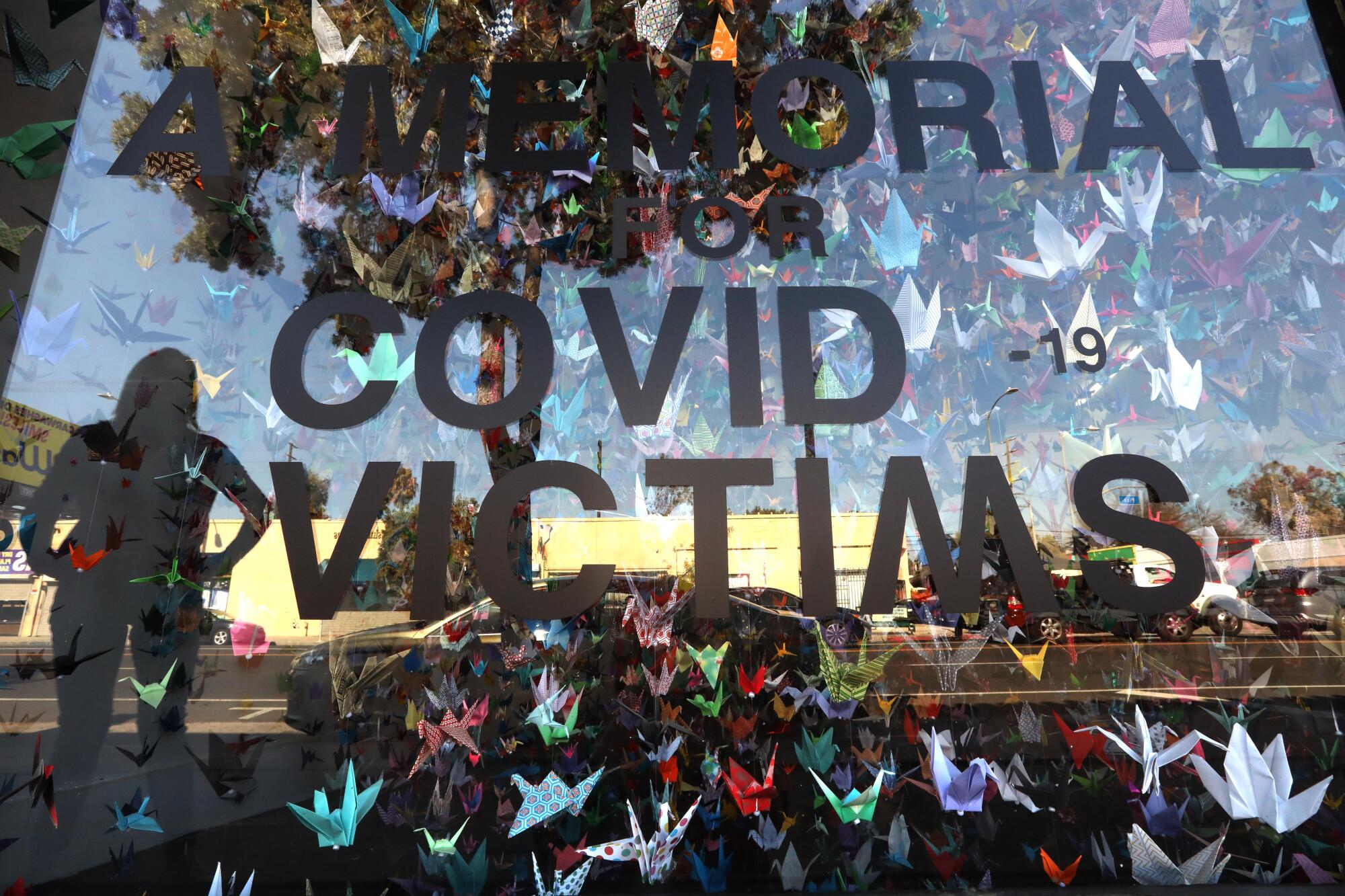
At Funderburk’s gallery, she too has become the custodian of people’s memories.
Many of those who dropped off donations or visited her crane exhibition shared anecdotes about people who had died. Funderburk began inviting them to record short audio clips.
“I realized that I had to tell the stories,” she said, her voice breaking. “I couldn’t hold it all by myself.”
People began describing those they had lost.
Exequiel Montoya, a restaurant owner known for his booming voice and giant heart, died Aug. 14: Everyone loved him, everyone adored him. He was just such a great man.
Bunny Lawton, avid bird-watcher and the second in four generations of female artists, died Sept. 2: It’s worth noting that by her own design, she left this life singing with my brother and me the silly songs she taught us when we were little.
Carol White, who loved brisket, root beer floats and her wife of many years, died Jan. 19: She wrote a list. Stuck it on the calendar, chronicling every topic we — she and I — have yet to discuss, explore, unearth. Next time.
Funderburk hopes to create satellite installations throughout the country, each with a QR code that people can scan to hear the recordings. The first, in Tarzana, opens Wednesday with about 18,000 cranes on display.
Back in her gallery, about 11,000 more cranes are hanging, while the floor is lined with boxes and envelopes full of paper birds waiting to take flight.
More to Read
Sign up for Essential California
The most important California stories and recommendations in your inbox every morning.
You may occasionally receive promotional content from the Los Angeles Times.
